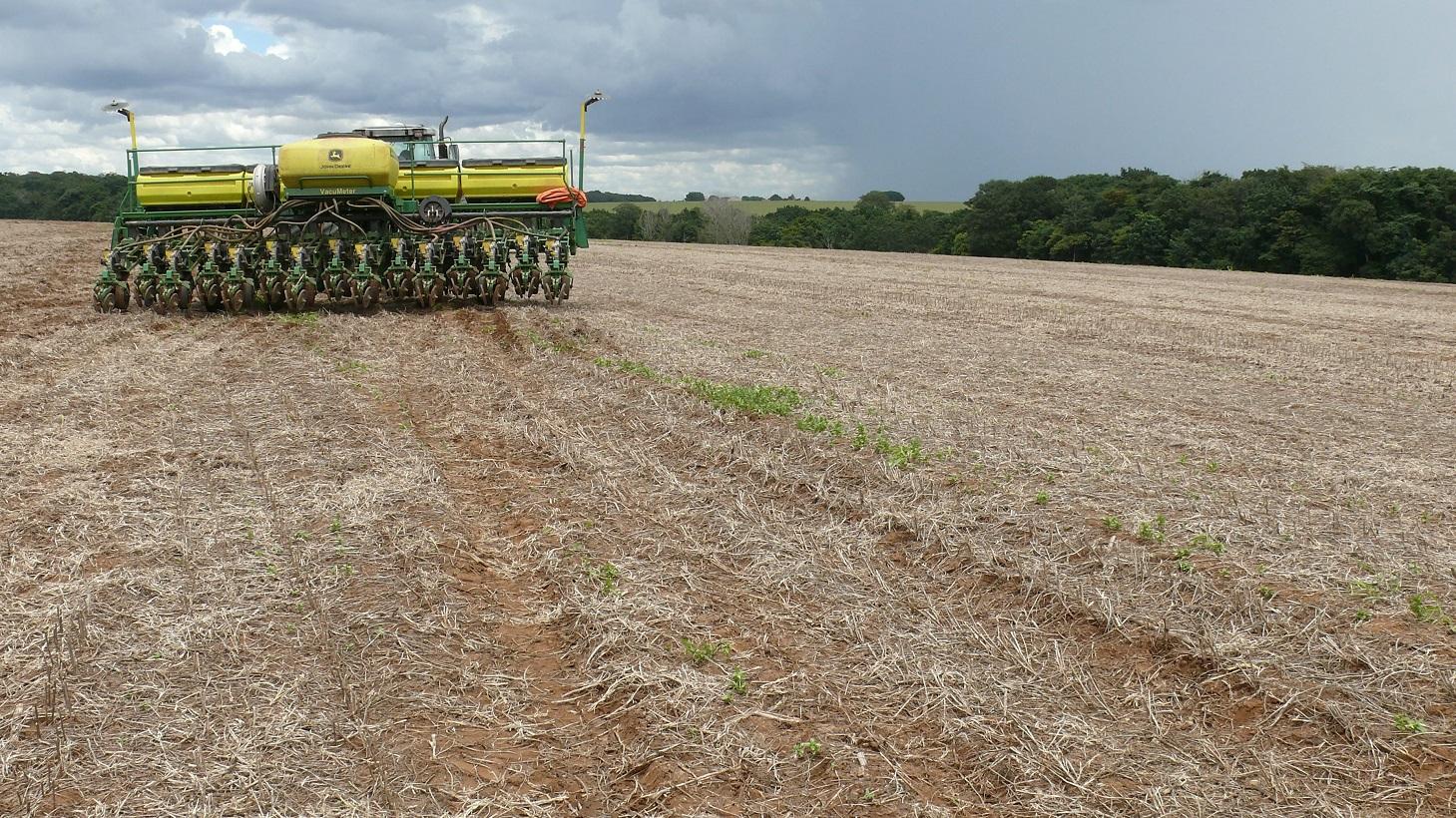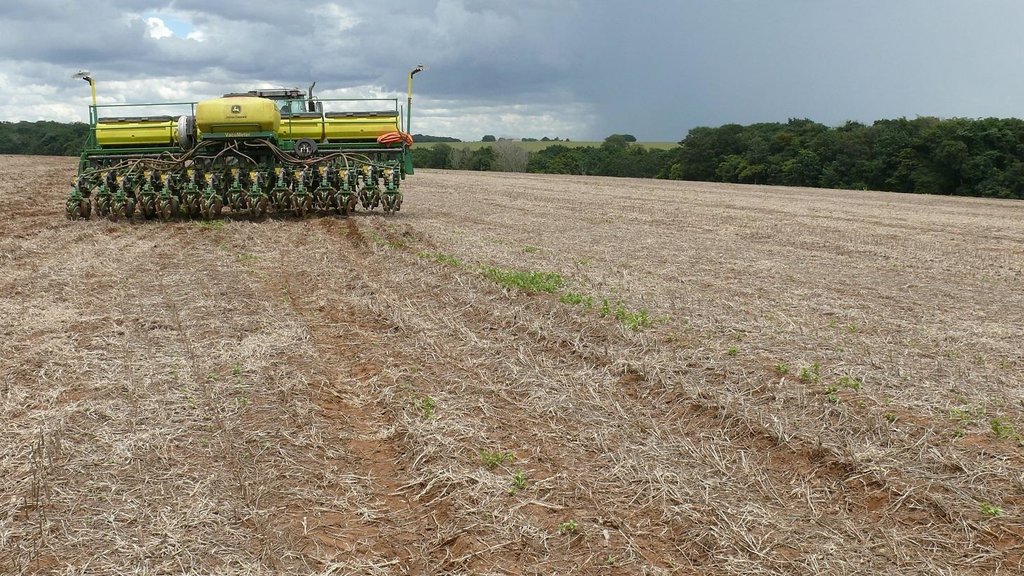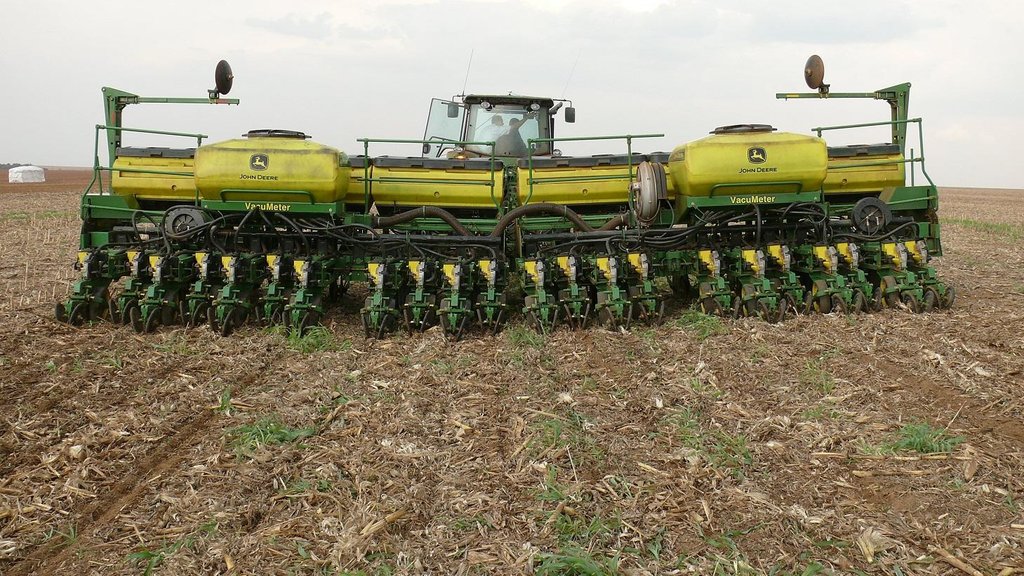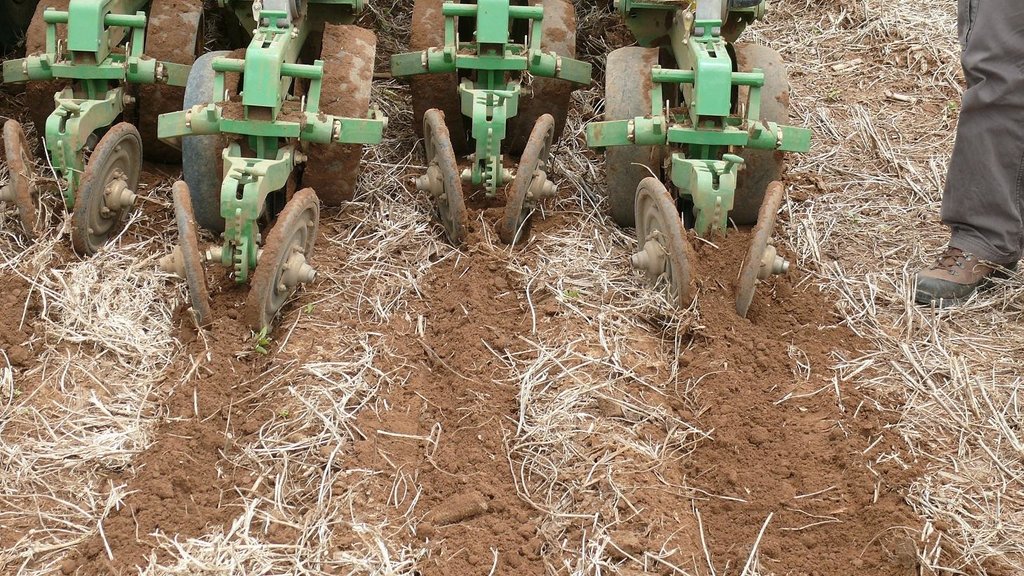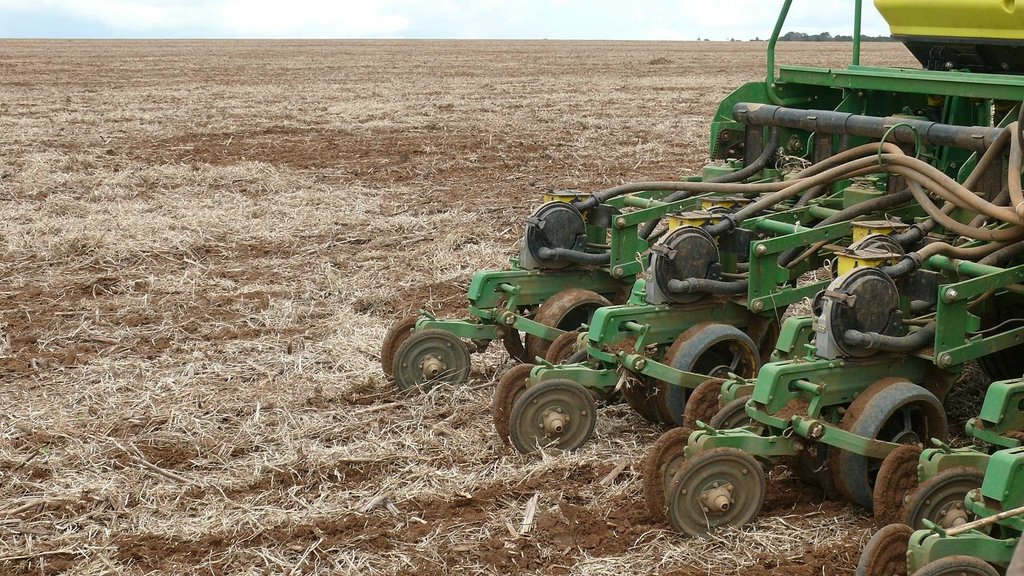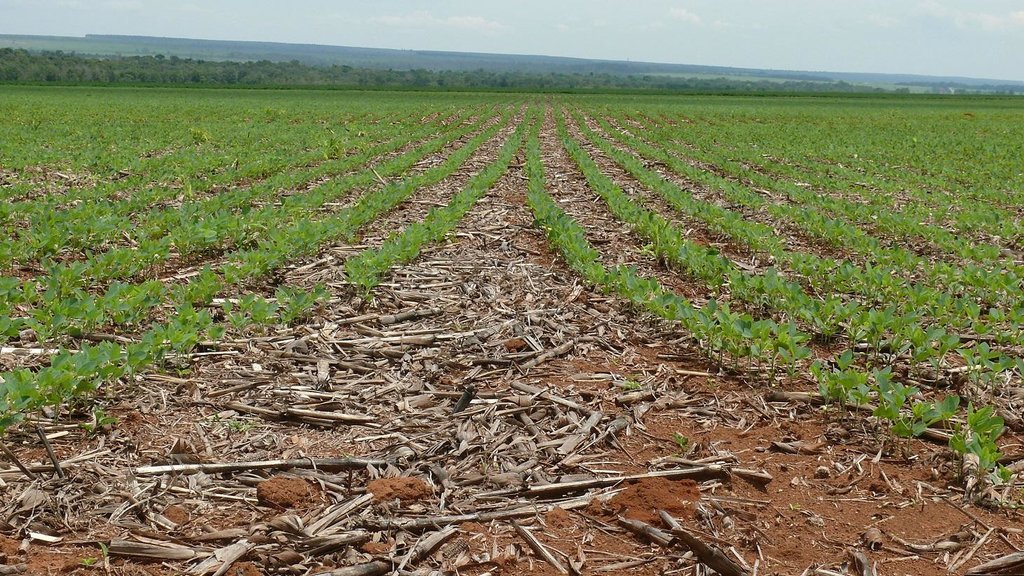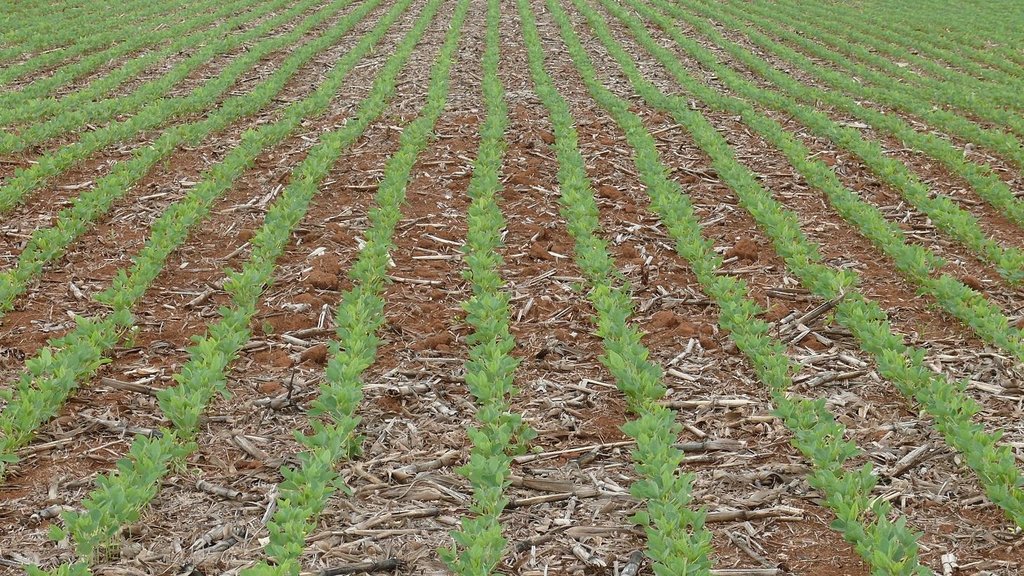Minimum tillage [Brazil]
- Creation:
- Update:
- Compiler: Stefan Hohnwald
- Editor: –
- Reviewer: Alexandra Gavilano
Plantio direto
technologies_1270 - Brazil
View sections
Expand all Collapse all1. General information
1.2 Contact details of resource persons and institutions involved in the assessment and documentation of the Technology
SLM specialist:
Schindewolf Marcus
+49 3731 390
Technische Universität Bergakademie Freiberg
Akademiestraße 6, 09599 Freiberg, Germany
Germany
Name of the institution(s) which facilitated the documentation/ evaluation of the Technology (if relevant)
Technische Universität Bergakademie Freiberg - GermanyName of the institution(s) which facilitated the documentation/ evaluation of the Technology (if relevant)
Georg August Universität Göttingen (Georg August Universität Göttingen) - Germany1.3 Conditions regarding the use of data documented through WOCAT
When were the data compiled (in the field)?
20/07/2015
The compiler and key resource person(s) accept the conditions regarding the use of data documented through WOCAT:
Yes
2. Description of the SLM Technology
2.1 Short description of the Technology
Definition of the Technology:
Seed of maize and soy are planted directly into the soil with a minimum previous tillage impact.
2.2 Detailed description of the Technology
Description:
After harvesting stubbles of maize or soy remain on site. When the planting season started the soil is opened by rolling discs pulled by a tractor. The seeds are directly put into the open soil which is compacted afterwards with rolling wheels of the same machine.
Purpose of the Technology: With minimum tillage practices tilling and seeding operations could be implemented fast and very efficient. The high power of impact allows the cultivation of large fields in short time, especially if small windows of wet initial conditions need to be used. The purpose is to avoid deep plowing of the soils that would need much higher energy and costs and would lead to typical serious erosion problems in the tropics.
Establishment / maintenance activities and inputs: The technology was implemented in the area since approximately 15 years. High technological standard of tillage tools, tractors and service is needed. Since the whole farm system has changed, farmer need special knowledge in no-till measures especially with regard to pest management.
Natural / human environment: The region belongs to the semi-humid tropics and to the cerrado biome in the centre of the South American continent. Natural vegetation has been deforested some 20-40 year ago and was shifted to soy bean fields, pastures, corn and sugar cane fields.
2.3 Photos of the Technology
2.5 Country/ region/ locations where the Technology has been applied and which are covered by this assessment
Country:
Brazil
Region/ State/ Province:
Mato Grosso
Further specification of location:
Campo Verde, Primavera do Leste
Comments:
Boundary points of the Technology area: Flat cerrado biome of Brazil
Map
×2.6 Date of implementation
If precise year is not known, indicate approximate date:
- 10-50 years ago
2.7 Introduction of the Technology
Specify how the Technology was introduced:
- through land users' innovation
3. Classification of the SLM Technology
3.2 Current land use type(s) where the Technology is applied

Cropland
- Annual cropping
Main crops (cash and food crops):
Major cash crop annual cropping:
Major cash crop mixed cropping: Corn and cotton

Forest/ woodlands
Products and services:
- Timber
- Fuelwood
- Nature conservation/ protection
Comments:
Major land use problems (compiler’s opinion): biodiversity loss, water pollution, soil erosion
Major land use problems (land users’ perception): unpredictable weather, unpredictable world market prices, climate change
Forest products and services: timber, fuelwood, nature conservation / protection
Type of cropping system and major crops comments: Sometimes Pearl millet is planted as an inter-crop.
3.3 Further information about land use
Comments:
Water supply: rainfed
Number of growing seasons per year:
- 2
Specify:
Longest growing period in days: 150 Longest growing period from month to month: September-January Second longest growing period in days: 100 Second longest growing period from month to month: January-July
3.4 SLM group to which the Technology belongs
- minimal soil disturbance
3.5 Spread of the Technology
Specify the spread of the Technology:
- evenly spread over an area
If the Technology is evenly spread over an area, indicate approximate area covered:
- > 10,000 km2
Comments:
The area in which the SLM technology is applied is much bigger and can be found also in other states of Brazil that is located in the cerrado biome.
3.6 SLM measures comprising the Technology

agronomic measures
- A1: Vegetation/ soil cover
- A3: Soil surface treatment

structural measures
- S1: Terraces

management measures
- M1: Change of land use type
- M2: Change of management/ intensity level
- M6: Waste management (recycling, re-use or reduce)
Comments:
Main measures: agronomic measures, structural measures, management measures
Type of agronomic measures: better crop cover, mixed cropping / intercropping, cover cropping, legume inter-planting, manure / compost / residues, mineral (inorganic) fertilizers, zero tillage / no-till, minimum tillage
3.7 Main types of land degradation addressed by the Technology

soil erosion by water
- Wt: loss of topsoil/ surface erosion
Comments:
Main type of degradation addressed: Wt: loss of topsoil / surface erosion
Main causes of degradation: soil management, deforestation / removal of natural vegetation (incl. forest fires), Heavy / extreme rainfall (intensity/amounts), droughts
Secondary causes of degradation: crop management (annual, perennial, tree/shrub), change of seasonal rainfall, wind storms / dust storms, floods
3.8 Prevention, reduction, or restoration of land degradation
Comments:
Main goals: prevention of land degradation
Secondary goals: mitigation / reduction of land degradation,
Third goal: rehabilitation / reclamation of denuded land
4. Technical specifications, implementation activities, inputs, and costs
4.2 Technical specifications/ explanations of technical drawing
Technical knowledge required for field staff / advisors: high
Technical knowledge required for land users: high
Main technical functions: control of dispersed runoff: retain / trap, control of dispersed runoff: impede / retard, control of concentrated runoff: retain / trap, control of concentrated runoff: impede / retard, improvement of ground cover, increase in nutrient availability (supply, recycling,…), increase / maintain water stored in soil
Secondary technical functions: control of raindrop splash, reduction of slope angle, reduction of slope length, increase of surface roughness, improvement of surface structure (crusting, sealing), improvement of topsoil structure (compaction), improvement of subsoil structure (hardpan), increase in organic matter, increase of infiltration, increase of groundwater level / recharge of groundwater, water harvesting / increase water supply, water spreading, increase of biomass (quantity)
Better crop cover
Material/ species: stubbles
Mixed cropping / intercropping
Material/ species: safrinha
Cover cropping
Material/ species: stubbles
Terrace: backward sloping
Vertical interval between structures (m): 2
Spacing between structures (m): 50
Bund/ bank: level
Vertical interval between structures (m): 0.5
Spacing between structures (m): 50
4.3 General information regarding the calculation of inputs and costs
other/ national currency (specify):
Real Brasileiro
Indicate exchange rate from USD to local currency (if relevant): 1 USD =:
3.06
Indicate average wage cost of hired labour per day:
15.00
4.4 Establishment activities
| Activity | Type of measure | Timing | |
|---|---|---|---|
| 1. | Bulldozing | Structural | dry season |
4.5 Costs and inputs needed for establishment
| Specify input | Unit | Quantity | Costs per Unit | Total costs per input | % of costs borne by land users | |
|---|---|---|---|---|---|---|
| Labour | Bulldozing | ha | 1.0 | 3000.0 | 3000.0 | |
| Total costs for establishment of the Technology | 3000.0 | |||||
4.6 Maintenance/ recurrent activities
| Activity | Type of measure | Timing/ frequency | |
|---|---|---|---|
| 1. | reparation | Agronomic | yearly |
4.8 Most important factors affecting the costs
Describe the most determinate factors affecting the costs:
Costs are determined by the enormous field size and the soil type
5. Natural and human environment
5.1 Climate
Annual rainfall
- < 250 mm
- 251-500 mm
- 501-750 mm
- 751-1,000 mm
- 1,001-1,500 mm
- 1,501-2,000 mm
- 2,001-3,000 mm
- 3,001-4,000 mm
- > 4,000 mm
Specifications/ comments on rainfall:
September-April
Agro-climatic zone
- sub-humid
Thermal climate class: tropics. 25.6
5.2 Topography
Slopes on average:
- flat (0-2%)
- gentle (3-5%)
- moderate (6-10%)
- rolling (11-15%)
- hilly (16-30%)
- steep (31-60%)
- very steep (>60%)
Landforms:
- plateau/plains
- ridges
- mountain slopes
- hill slopes
- footslopes
- valley floors
Altitudinal zone:
- 0-100 m a.s.l.
- 101-500 m a.s.l.
- 501-1,000 m a.s.l.
- 1,001-1,500 m a.s.l.
- 1,501-2,000 m a.s.l.
- 2,001-2,500 m a.s.l.
- 2,501-3,000 m a.s.l.
- 3,001-4,000 m a.s.l.
- > 4,000 m a.s.l.
Comments and further specifications on topography:
Altitudinal zone: 501-1000 m a.s.l. (630 m)
5.3 Soils
Soil depth on average:
- very shallow (0-20 cm)
- shallow (21-50 cm)
- moderately deep (51-80 cm)
- deep (81-120 cm)
- very deep (> 120 cm)
Soil texture (topsoil):
- coarse/ light (sandy)
Topsoil organic matter:
- medium (1-3%)
- low (<1%)
If available, attach full soil description or specify the available information, e.g. soil type, soil PH/ acidity, Cation Exchange Capacity, nitrogen, salinity etc.
Soil fertility: Low
Soil drainage/infiltration: Good
Soil water storage capacity: Very low
5.4 Water availability and quality
Ground water table:
5-50 m
Availability of surface water:
medium
Water quality (untreated):
for agricultural use only (irrigation)
5.5 Biodiversity
Species diversity:
- high
5.6 Characteristics of land users applying the Technology
Market orientation of production system:
- commercial/ market
Off-farm income:
- 10-50% of all income
Relative level of wealth:
- rich
- very rich
Individuals or groups:
- individual/ household
Level of mechanization:
- mechanized/ motorized
Gender:
- men
Indicate other relevant characteristics of the land users:
Land users applying the Technology are mainly Leaders / privileged
Population density: < 10 persons/km2
Annual population growth: 3% - 4%
5.7 Average area of land owned or leased by land users applying the Technology
- < 0.5 ha
- 0.5-1 ha
- 1-2 ha
- 2-5 ha
- 5-15 ha
- 15-50 ha
- 50-100 ha
- 100-500 ha
- 500-1,000 ha
- 1,000-10,000 ha
- > 10,000 ha
Is this considered small-, medium- or large-scale (referring to local context)?
- large-scale
5.8 Land ownership, land use rights, and water use rights
Land ownership:
- company
Land use rights:
- individual
Water use rights:
- individual
5.9 Access to services and infrastructure
health:
- poor
- moderate
- good
education:
- poor
- moderate
- good
technical assistance:
- poor
- moderate
- good
employment (e.g. off-farm):
- poor
- moderate
- good
markets:
- poor
- moderate
- good
energy:
- poor
- moderate
- good
roads and transport:
- poor
- moderate
- good
drinking water and sanitation:
- poor
- moderate
- good
financial services:
- poor
- moderate
- good
6. Impacts and concluding statements
6.1 On-site impacts the Technology has shown
Socio-economic impacts
Production
crop production
production area
land management
energy generation
Income and costs
expenses on agricultural inputs
Socio-cultural impacts
conflict mitigation
Ecological impacts
Water cycle/ runoff
water quantity
water quality
surface runoff
excess water drainage
groundwater table/ aquifer
evaporation
Soil
soil moisture
soil cover
soil loss
soil compaction
nutrient cycling/ recharge
soil organic matter/ below ground C
Biodiversity: vegetation, animals
biomass/ above ground C
Climate and disaster risk reduction
emission of carbon and greenhouse gases
wind velocity
6.2 Off-site impacts the Technology has shown
water availability
reliable and stable stream flows in dry season
downstream flooding
wind transported sediments
6.3 Exposure and sensitivity of the Technology to gradual climate change and climate-related extremes/ disasters (as perceived by land users)
Gradual climate change
Gradual climate change
| Season | Type of climatic change/ extreme | How does the Technology cope with it? | |
|---|---|---|---|
| annual temperature | increase | not well |
Climate-related extremes (disasters)
Meteorological disasters
| How does the Technology cope with it? | |
|---|---|
| local rainstorm | not well |
| local windstorm | not known |
Climatological disasters
| How does the Technology cope with it? | |
|---|---|
| drought | not well |
Hydrological disasters
| How does the Technology cope with it? | |
|---|---|
| general (river) flood | not well |
Other climate-related consequences
Other climate-related consequences
| How does the Technology cope with it? | |
|---|---|
| reduced growing period | not well |
6.4 Cost-benefit analysis
How do the benefits compare with the establishment costs (from land users’ perspective)?
Short-term returns:
negative
Long-term returns:
slightly positive
How do the benefits compare with the maintenance/ recurrent costs (from land users' perspective)?
Short-term returns:
neutral/ balanced
Long-term returns:
slightly positive
6.5 Adoption of the Technology
Of all those who have adopted the Technology, how many have did so spontaneously, i.e. without receiving any material incentives/ payments?
- 90-100%
Comments:
90% of land user families have adopted the Technology without any external material support
There is a moderate trend towards spontaneous adoption of the Technology
6.7 Strengths/ advantages/ opportunities of the Technology
| Strengths/ advantages/ opportunities in the compiler’s or other key resource person’s view |
|---|
| The no-tillage technology reduced soil erosion by water and helps to minimize carbon release into the atmosphere. It reduces management costs in the long run. |
6.8 Weaknesses/ disadvantages/ risks of the Technology and ways of overcoming them
| Weaknesses/ disadvantages/ risks in the compiler’s or other key resource person’s view | How can they be overcome? |
|---|---|
| No tillage is a high-input technology that needs some expensive investments in the beginning. |
Links and modules
Expand all Collapse allLinks
No links
Modules
No modules


